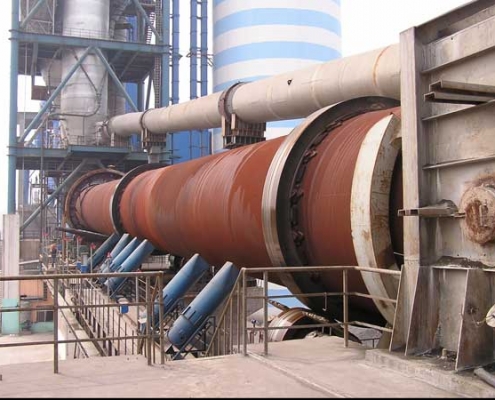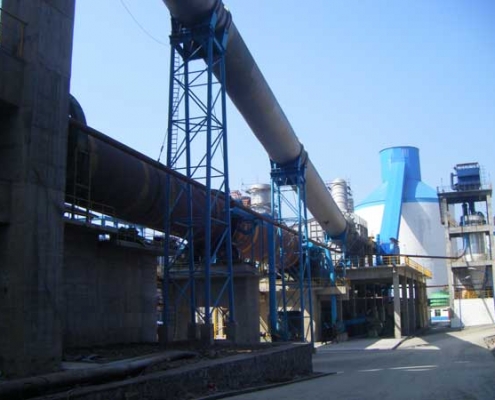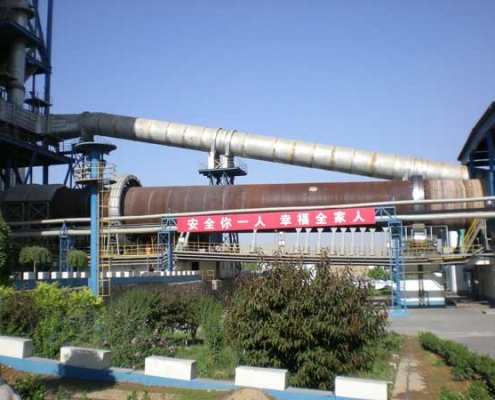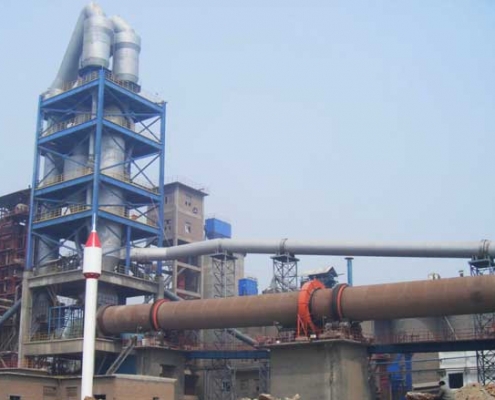Cement rotary kiln introduction
LCDRI cement rotary kiln can meet the construction requirements of 1000-12000 tpd cement production line plant, with the advantage of easy operation, high output and smooth running.
| Capacity: | 1000-12000 tpd |
| Shell diameter: | Φ3.2m-Φ6.2m |
| Applications: | 600-8000 tpd cement production line plant |
Cement rotary kiln structure
The cement rotary kiln consists of a cylinder block, a transmission, a support device, a roller, a kiln, a kiln seal, a kiln head and a fuel system.
The kiln body and the horizontal rotary kiln have a certain inclination. The whole kiln body is composed of a roller support device and a control wheel device to prevent the movement of the kiln body.
In addition to the main transmission, the transmission system can still make the kiln body break when the main power supply rotates, preventing the kiln auxiliary gear from bending and deforming. The kiln tail sealing device at the kiln end adopts advanced technology to ensure the reliability of the seal.
Cement rotary kiln process description
As the main equipment of dry process cement clinker production line plant, which is the most efficient clinker calcining equipment. LCDRI cement rotary kiln can meet the construction requirement of 1000-12000 tpd cement production line plant, with the advantage of easy operation, high output and smooth running. In appearance, the kiln shell is inclined to a certain level. The whole kiln shell is supported by supporting roller and equipped with thrust roller to prevent it from moving up and down. In addition to the main drive, the transmission system is also provided with an auxiliary driving device which can still rotate the kiln shell and prevent the bending of the kiln shell when the main power supply is off. The material is fed into the upper end of the smoking chamber. As the shell rotating, the materials gradually move towards the lower end, and they may go a certain amount of stirring and mixing. Hot gas goes through the rotary kiln, in the opposite direction with the processed materials. The hot gas may be generated in an external furnace, or may be generated by flames inside the kiln. They are repetitively scattered in the air so that they are in full contact with the hot air, the materials are dried gradually. The kiln head and kiln end adopts advanced sealing technology to ensure the reliability of the seal. LCDRI cement rotary kiln is currently the most reasonable investment in a rotary kiln equipment. Compared with the traditional wet kiln, it is the best for cost saving and pollution reduction in cement production industry in the world.
Cement rotary kiln features
1.It can be used for 1000-12000 tpd cement production line plant, LCDRI cement rotary kiln has a series of scales, which can meet the customer’s different production configuration.
2. Advanced technology and easy maintenance, through the technology innovation, rotary kiln calcining system uses the world’s most advanced hydraulic wheel device, it could solve the problems that traditional rotary kiln equipment temperature is not easy to control, product quality is not stable, as well as the problems of environmental pollution and low heat problems. It has good finished product quality, and high yield.
3. Environmental protection, applied in different industries.
4. LCDRI provides a full set of cement equipment parts, LCDRI also provides a variety of cement rotary kiln spare parts.
CONTACT US
Cement rotary kiln specifications
1. Kiln shell is the trunk of rotary kiln, rolling and welding by quality thick steel plate, the plate thickness depends on the different stress of different position, rotate supporting roller adopt ZG35CrMo or 42CrMo steel.
2. Girth gear connect with kiln shell by spring board, and hanging on the kiln shell, the structure makes girth gear and kiln shell have enough heat dissipation space, and also reduce the kiln shell heat deformation and impact on the accuracy of gear engagement, besides it could have the effect of shock absorption, is helpful to prolong the working life of the rotary kiln.
3. The sealing device structure adopts labyrinth type and contact type, contact type including scale type, graphite block type, cylinder slip ring type and so on. The sealing effectively prevent the loss of heat, reduce the heat consumption, and improve the utilization of fuel.
|
SN |
Specification |
Production capacity |
Rotate speed of kiln shell |
Motor power |
Weight |
|
m |
t/d |
r/min |
kw |
t |
|
|
1 |
Φ3.2×50 |
1000 |
0.36~3.57 |
160 |
259 |
|
2 |
Φ3.3×50 |
1200 |
0.36~3.57 |
160 |
266 |
|
3 |
Φ3.5×52 |
1500 |
0.35~3.51 |
190 |
318 |
|
4 |
Φ3.5×54 |
1500 |
0.41~4.06 |
250 |
327 |
|
5 |
Φ4.0×60 |
2500 |
0.41~4.07 |
315 |
446 |
|
6 |
Φ4.2×60 |
3000 |
0.4~3.98 |
375 |
491 |
|
7 |
Φ4.3×60 |
3200 |
0.4~4.0 |
400 |
536 |
|
8 |
Φ4.3×62 |
3200 |
0.4~4.0 |
420 |
547.5 |
|
9 |
Φ4.3×64 |
3500 |
0.4~4.0 |
420 |
552 |
|
10 |
Φ4.3×66 |
3500 |
0.4~4.0 |
450 |
560 |
|
11 |
Φ4.8×74 |
5000 |
0.35~4.0 |
630 |
859 |
|
12 |
Φ5.0×74 |
6000 |
0.35~4.0 |
710 |
877 |
|
13 |
Φ5.6×87 |
8000 |
0.35~4.0 |
800 |
1201 |
|
14 |
Φ6.0×95 |
10000 |
0.35~4.0 |
950×2 |
1580 |
|
15 |
Φ6.2×96 |
12000 |
0.35~4.0 |
1100×2 |
1730 |
Industry application
(1) In addition to calcined cement clinker, it is also used for calcining clay, limestone and slag drying;
(2) In the production of refractory materials, the rotary kiln is used to calcine the raw materials to make the dimensional stability, strength increase, and re-forming.
(3) In non-ferrous and ferrous metallurgy, metals such as iron, aluminum, copper, zinc, tin, nickel, tungsten, chromium, and antimony are used as smelting equipment for rotary kiln to sinter and roast ore, concentrate, and intermediates. For example, it is used in aluminum production to roast aluminum hydroxide into alumina; in iron making, it is used to produce pellets for blast furnace ironmaking; foreign “SL/RN method” and “Krupp method” use it for iron ore Direct reduction; chlorination volatilization roasting method is used to extract tin and lead.
(4) During the beneficiation process, the lean kiln is used to magnetize the lean iron ore to change the original weak magnetic properties of the ore to strong magnetic properties to facilitate magnetic separation.
(5) In the chemical industry, the rotary kiln is used to produce soda, calcined phosphate fertilizer, and strontium sulfide. The method has the advantages of low energy consumption, low power consumption, no use of sulfuric acid and available medium and low grade phosphate rock, and is quickly popularized.
(6) In addition to this, it is very good in environmental protection. It uses fuel rotary kiln to incinerate hazardous waste and garbage. This not only reduces waste and harmless waste, but also uses waste as fuel to save coal powder. To the recycling of waste.





